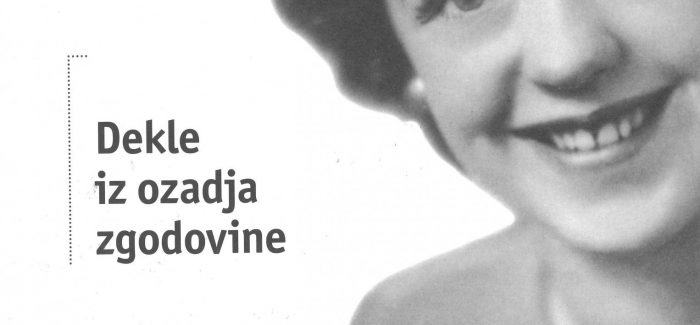Monography THE GIRL FROM THE BACKGROUND OF HISTORY – Ljudmila Belcijan and her journey to Africa with the family of prince Paul Karađorđević
Who was the girl from the background of history?
Ljudmila (Milka) Belcijan was born on 16 September 1924 in Vinje (Dol pri Ljubljani) to her mother Marija (née Virt) and father Janez. There were four children in the family: Ljudmila, Mimi, Jože and Franc. The Belcijan family moved to a rented house in Predoslje. Ljudmila finished six grades of primary school there. She attended a sewing course in Ljubljana, as she wanted to become a teacher of handicrafts. When she was fifteen, she broadened her experience in Macarol Sewing Workshop in Kranj.
The proximity of the Brdo Castle affected the residents of Predoslje, especially after 1935, when the castle became the summer residence of the family of Prince Paul Karađorđević, the Regent of the Kingdom of Yugoslavia. Ljudmila Belcijan first worked at the Brdo Castle, and later also at the White Palace in Belgrade. Her duties varied from cleaning, laundering, ironing and sewing to babysitting Paul’s daughter, Princess Elisabeth.
When ruled by Prince Paul, the Kingdom of Yugoslavia joined the Tripartite Pact in order to avoid the military conflict with Hitler’s Germany and Mussolini’s Italy. On 27 March 1941, the army launched a coup, overthrew the government, abolished the regency and proclaimed the minor King Peter II an adult. Prince Paul and his family were forced to withdraw to Kenya, to Lake Naivasha (north of Nairobi), where they were interned under the British control. Ljudmila Belcijan left with them as well. In March 1943, the British authorities approved the family to move to Johannesburg, South Africa, due to Prince Paul’s poor health. Ljudmila married there for the first time in December 1945 and started a new life. Prince Paul and his family moved to Switzerland in October 1948, and four years later, on to Paris, where the Prince died in 1976. Paul’s wife, Princess Olga, corresponded with Ljudmila all her life. The Princess was very curious as to how her family lived in Africa, and in every letter, she asked about her family in Slovenia whom Ljudmila visited every seven or eight years.
Ljudmila Belcijan’s legacy in the Museum of Gorenjska
Ljudmila Belcijan, who adopted the surname de Lange after her second marriage, left all her African memorabilia to her niece Zvonka Podboršek. Ms Podboršek handed the majority of the legacy to the Museum of Gorenjska in 2018 and 2019. Due to her employment with the Prince Regent Paul Karađorđević, Ljudmila migrated several times, which marked her life profoundly. We anticipated the legacy to convey impressions of life in Africa, but as it turned out, Ljudmila was desperately homesick. In her diaries, which she began writing at the White Palace in 1941, she frequently mentions her family and village life with friends. Her thoughts usually conclude with memories of her home, with her fervent wish for return and a prayer. Her legacy provides an important source for exploring the history of everyday life in Predoslje with its surroundings, and at the same time, offers a unique insight into the life of a young girl who left her homeland on the verge of World War II, unexpectedly and in a hurry, and as it turned out, for good.
The obtained material includes, among other things, three diaries from 1941 to 1943, two memory books, sound recording on the voice recorder, album with stamps, over 140 letters, 50 postcards, 250 photographs, 20 different documents and some personal items (a brooch, necklaces, earrings). The material also contains two books on Prince Paul, which Ljudmila’s niece Zvonka received as a gift from Princess Elisabeth when she visited Belgrade in May 2014.
While exploring the legacy of Ljudmila Belcijan, the Museum of Gorenjska connected with the Slovene Ethnographic Museum, which documents Slovenian contacts with Africa systematically, and with the Historical Archives of Ljubljana, Gorenjska Unit Kranj. The purpose of this exhibition is to present all the acquired material and offer numerous possibilities for further research, particularly among Ljudmila Belcijan’s relatives and acquaintances. Already during the preparation of the exhibition, her granddaughter visited the museum, and some contacts were established with her relatives in South Africa and with the descendants of the staff who worked at the Brdo Castle before World War II. Just recently, the museum acquired further 40 photographs and 6 letters, and recorded 23 photographs and 4 postcards. It is our wish to supplement the documentation further in order to complete the story about Ljudmila Belcijan, the girl from the background of history.


